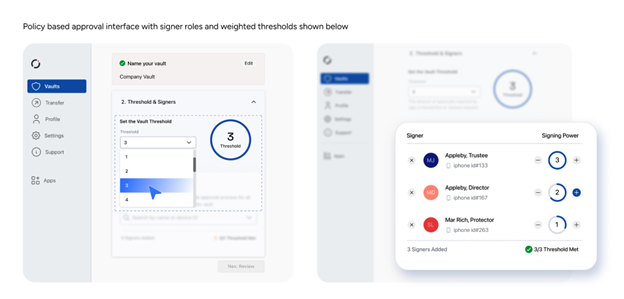Why Digital Assets Challenge The Old Playbook
With traditional assets, FSPs usually rely on intermediaries and transfer agents, with the assurance that an honest mistake can usually be corrected through a simple recall request. Digital assets work differently. Control rests entirely on a cryptographic private key. Lose it, and the asset is gone. Share it with the wrong person, and the wealth can vanish instantly with no recourse. For FSPs, this reality translates into three critical risks that require careful attention:
- Loss of access occurs when a private key is easily misplaced or destroyed.
- Unauthorised access occurs when a private key is stolen, hacked, or misused.
- Operational exposure occurs when reliance on weak systems or counterparties creates single points of failure.
Mitigating these risks begins with choosing the appropriate custody model.
Preserving Digital Assets
Preservation begins with custody. FSPs must consider how digital assets will be held, and the options vary depending on resources, expertise, and risk tolerance.
Custodial Accounts
Should there be limited resources and technical capacity, custodians offer a fast route to market. They reduce operational burden and simplify compliance. The trade-off is counterparty risk, as the digital asset’s safety is reliant on the custodian’s solvency and control measures.
We have seen examples of exchanges and service providers failing, leaving clients with losses. As a result, many investors are uneasy with a custodian model and increasingly prefer approaches that provide shared control of assets.
Hybrid Custody
Hybrid custody offers a practical middle ground. In this model, responsibility is shared between the FSP and a trusted service provider. The director or trustee remains the ultimate approver for all transactions and recovery decisions. A service provider has shared control of digital assets, providing redundancy, technical support, and a safeguard against potential counterparty risks.
This approach continues to ensure FSPs retain control and discretion, while a third party provides redundancy where needed. Done correctly, it combines resilience with peace of mind, striking a balance between direct control and operational support.
Self-Custody
Recently, we’ve seen FSPs with sufficient technical capacity pursue full self-custody solutions. This approach eliminates counterparty risk and provides full control, nonetheless, results in a greater operational burden. Successful self-custody frameworks should require carefully designed, regularly tested, and audited policies and procedures to maintain security and resilience.
When implemented correctly, this model allows FSPs to demonstrate competence while maintaining direct control.
Governance And Security: Preventing Misuse
Protection means more than secure custody. It requires clear rules and oversight on how assets can be transferred in line with policies and procedures. In traditional banking, the rudimentary solution generally involves dual signatories and approval thresholds built into core systems.
Digital assets are different. Transfers rely on cryptographic signatures and private keys, which add complexity to the infrastructure. With early adopters of digital assets, individuals and FSPs relied on Multisignature Wallets (MultiSigs). These MultiSigs create three separate private keys, and require two of the three private keys to approve a transaction.
Institutional Standard: Multi-Party Computation (MPC)
In recent years, a stronger standard has emerged: Multi-Party Computation (MPC). Unlike MultiSigs, MPC uses one private key that is split into cryptographic shares. No one ever holds the full key. The key can also be divided into many shares, not just three, and rules can be set with weighted signatories and approval thresholds.
This standard aligns digital asset policies and procedures with FSP good governance obligations to help bridge the adoption gap, and offers clear advantages over MultiSigs to enable:
- Chain agnostic functionality – Works across blockchains.
- Flexible approval policies – M of N number of approvals.
- Off-chain privacy – Signing occurs off-chain, unlike visible on-chain MultiSigs.
- Secure enclaves – Key shares stored in tamper-resistant hardware.
- Biometric authentication – Human signers verified by physical authentication.
- Robust recovery protocols – Recovery adds redundancy through the flexibility to involve an unlimited number of parties.
In practice, MPC allows FSPs to configure governance in ways that mirror familiar trust and independent director approval scenarios. Approvals can be set up with weighted voting rights, giving different levels of authority to different parties. Reserved powers can be built in, allowing the necessary parties to retain defined approval rights. Segregation of duties is also possible, with trustees, protectors, and administrators each holding distinct roles in the approval process.
Examples Of Functions
- Trust with protector: The trustee holds three key shares, the protector holds two, and a licensed custodian holds two for redundancy. Transactions require three of seven approvals. Because the protector holds two shares, this setup can reflect a negative power of veto. If the trustee approves but the protector rejects, the transaction cannot proceed.
- Treasury management: A CIO can hold authority to invest stablecoins into approved yield funds. Transfers above set limits require trustee approval, and transactions are restricted to whitelisted addresses.
- Operational payments: An administrator inputs a payment through a shared policy framework where stakeholders each play their role, and the director provides final sign-off. This ensures compliant payments towards service providers such as software, marketing, insurance and salaries. Using stablecoins can also alleviate the cost of cross-border transactions and reduce lead times.
These models demonstrate how MPC can embed FSP oversight directly into custody operations.
What Can FSPs Do Now?
To remain relevant and responsible stewards of wealth. FSPs should:
- Understand custody frameworks: Custodial, hybrid, and self-custody each have unique advantages.
- Align policies and procedures with technology: Good governance should match the custody framework.
- Invest in education: Build internal competence before clients’ demand surges.
Moving Forward With Urgency
Digital assets are advancing faster than past technological shifts. Like AI, they will reshape legacy systems, and the real economy is likely to become more tokenised within the next decade. FSPs must act now – with prudence, foresight, and strategic clarity – to ensure they are not merely reacting to change, but leading it.
First published by IFC Review, November 13 2025. You can access the original article, here.







